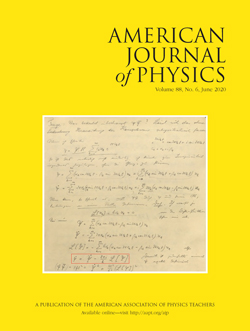 June 2020 Issue,
June 2020 Issue,
Volume 88, No. 6
In this paper, some of Schrödinger's initial struggles with the complex nature of his wave function are outlined. It is shown that he first attached physical meaning only to its real component and even tried to avoid the explicit appearance of the imaginary unit i in his fundamental (time-dependent) equation. This attitude is quite understandable, since he was committed to the classical framework of wave theory, not only ontologically, but also formally. Around one year after the publication of his famous papers on wave mechanics, Schrödinger seems to have accepted that the wave function must be complex and that the physical interpretation is to be related to its absolute square. This is justified by him both due to equivalence considerations with matrix mechanics and in analogy with Maxwell's equations. It is argued that an awareness of the struggles Schrödinger went through to accept a complex wave function can be a relief to students who themselves wonder why ψ needs to be complex when they encounter the topic for the first time.
What is unpleasant here, and indeed directly to be objected to, is the use of complex numbers.
ψ is surely fundamentally a real function (Schrödinger to Lorentz on June 6, 1926, our emphasis).1
EDITORIAL
Editorial: Blurbs, round II by Richard Price. DOI: 10.1119/10.0001228
LETTERS TO THE EDITOR
Incorrect predictions made by a popular flat-earth model by Bruce Sherwood. DOI: 10.1119/10.0000269
BACK OF THE ENVELOPE
Quantum mechanics in power-law potentials by Sanjoy Mahajan. DOI: 10.1119/10.0001197
PAPERS
Schrödinger's original struggles with a complex wave function by Ricardo Karam. DOI: 10.1119/10.0000852
The Péclet number of a casino: Diffusion and convection in a gambling context by Cedric J. Gommes and Joe Tharakan. DOI: 10.1119/10.0000957
Magnetostriction measurements with a low-cost magnetostrictive cantilever beam by D. Laumann, P. Hayes, C. Enzingmüller, I. Parchmann and E. Quandt. DOI: 10.1119/10.0000640
Experiment on percolation for Introductory Physics Laboratories—A case study by Daniel Dziob and Dagmara Sokolowska. DOI: 10.1119/10.0000810
Rolling along a square path: The dynamics of biased balls by Michael S. Wheatland, Rodney C. Cross, Andrew Ly, Michael Sacks and Karl Smith. DOI: 10.1119/10.0000905
Form of spinning liquids in diverse geometries by Paul Menker and Andrzej Herczynski. DOI: 10.1119/10.0001178
Computer simulation of Mermin's quantum device by Robert Ross. DOI: /10.1119/10.0000833
INSTRUCTIONAL LABORATORIES AND DEMONSTRATIONS
A fully manipulable damped driven harmonic oscillator using optical levitation by Javier Tello Marmolejo, Oscar Isaksson, Remigio Cabrera-Trujillo, Niels C. Giesselmann and Dag Hanstorp. DOI: 10.1119/10.0000960
NOTES AND DISCUSSIONS
A note on a straight gravity tunnel through a rotating body by Aleksander Simonic. DOI: 10.1119/10.0001181
ADVANCED TOPICS
The Hellmann–Feynman theorem at finite temperature by Marina Pons, Bruno Juliá-Díaz, Artur Polls, Arnau Rios and Isaac Vidaña. DOI: 10.1119/10.0001233
BOOK REVIEWS
Falling Felines and Fundamental Physics by David L. Hu. DOI: 10.1119/10.0001095
BOOKS RECEIVED
American Journal of Physics 88, 512 (2020); https://doi.org/10.1119/10.0001188
About AJP
General Information, Resources for Authors, Reviewers, and Readers

